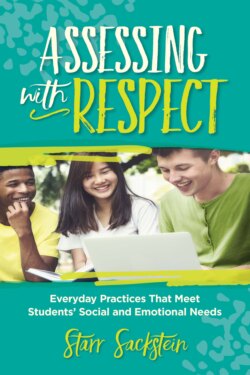Читать книгу Assessing with Respect - Starr Sackstein - Страница 25
На сайте Литреса книга снята с продажи.
Forming an LGBTQ+ Student Alliance
ОглавлениеSeveral years ago in our staff meetings, we began to have frequent discussions about how we were meeting the needs of our "subgroups" of students, both academically and emotionally. We would discuss different racial groups, students with IEPs, the "bottom third," and low-income students. I was always the voice at the table saying, "And our LGBTQ students!" Everyone would nod and agree. Then we would continue the conversation around all of our subgroups except the LGBTQ students. They were such a mixed group academically, racially, economically, and emotionally that no one really knew where to begin. We all knew we had students that were coming out and many others that were still figuring out their sexuality and identity. But no one knew the best way to support these students.
I thought and thought about what I could do, and finally decided that we needed to give these students a safe space and a voice. I wanted to provide them with a place where they could feel comfortable being themselves and where they could find other students that were going through similar life experiences. I wanted to show them that our building was filled with allies and was a place that would love and accept them, so in September I approached my administrators about starting an LGBTQ+ Student Alliance. They approved, and up went the rainbow posters. In October we had our first meeting, and it was a huge success. We would start each meeting with a time for sharing, and early in our meetings, one student shared that she was happy to know she wasn't alone. That made it all worth it. I wanted all of my beautiful Rainbow Warriors to know that they were seen, accepted, and loved. The LGBTQ+ Student Alliance has been a huge step to making that happen.
In the months since starting the club, I have noticed a shift in school culture. The most important change is that students that are LGBTQ+ seem to feel more comfortable expressing their sexuality to teachers and other students. At the midpoint of the year, a student told the club that though he had publicly identified as female previously, he was ready to identify as male to the school community. We were able to have open and frank conversations about his transition. Other adults in the building felt comfortable talking to the student about it, and when they didn't, they would talk to me. The students in the club told me that other students would ask them questions about the club that were curious but respectful. There was an open dialogue happening, which is exactly what I had hoped for. Change and acceptance are happening in our school community, allowing our LGBTQ+ students to feel supported and accepted, which has also spilled over into the way they participate and engage in class. Developing a truly accepting community where students feel they belong allows them to bring their whole selves to their learning. Teachers with this knowledge also have an opportunity to adjust their assessments based on what they know of these students, ensuring that language is inclusive and assessment design doesn't unintentionally cause harm.
—Jessica Cimini-Samuels, middle school science teacher and LGBTQ+ Student Alliance advisor at Marsh Avenue Expeditionary Learning School, Staten Island, New York
